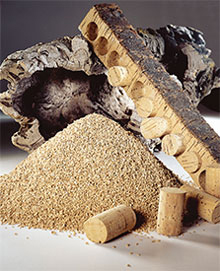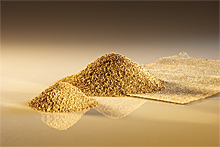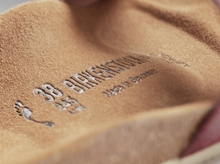THE BEST QUALITY
LAYER AFTER LAYER
SELECET MATERIALS FOR A UNIQUE PRODUCT
The original BIRKENSTOCK footbed is made of high-quality natural materials from renewable sources that are joined together in an elaborate production process: natural cork, natural latex, jute and high-quality suede, which is used as the top layer. Thanks to the gentle production process the materials retain their positive natural qualities.
NATURAL CORK: FLEXIBLE INSULATION MADE FROM NATURAL RECYCLED MATERIALS

Cork is a renewable resource. It is comprised of dead thin-walled cells that have been filled with air. This natural product is heat- and sound-insulating and also has water-repellent properties. The cork layer is reproduced and can therefore be harvested again and again.
The cork is obtained from the bark layer of the cork oak. At least five centimeters of thick bark is stripped from the cork oak – a process that, depending on weather conditions, can only be repeated every seven to nine years. A single tree can provide 100 to 200 kilograms of cork during its life. To ensure that the cork is hygienically clean the bark that has been removed is cooked thoroughly in tanks. It is then cut into strips that will be used to punch the bottle corks.
Natural cork oak forests only exist in the western Mediterranean basin. The majority of the cork processed by BIRKENSTOCK comes from southern Portugal. The country, situated in the western part of the Iberian peninsula, is the world's most important exporter of raw cork. Natural and planted cork oak forests in Portugal cover a total of some 750,000 hectares – about 8% of the total surface area of the country.
Because of its extraordinary properties – high elasticity, excellent cushioning and good insulation against heat, cold and moisture – cork is very popular as a universal raw material. All of these properties can also be found in the original BIRKENSTOCK footbed.
NATURAL LATEX: LIQUID RUBBER WITH EXTRAORDINARY ADHESIVENESS
Natural latex serves as a natural binding agent in the production of the footbed. The liquid, which is also called "rubber milk" because of its color and consistency, is blended with a mixture of soft and coarse cork granules. The dough-like mass is baked with two layers of jute and the top layer of suede at 100° C for several minutes. The substance is hardened through vulcanization. It retains the positive properties of the natural material.
Like cork, natural latex is also a renewable resource. Natural latex is obtained from the resin of rubber trees. The milky liquid is emitted as the plant's natural protective mechanism against bacteria and fungi. Rubber trees are native to tropical regions. When they are harvested the bark of the rubber tree is scored. The latex milk that is emitted is collected in small buckets. This is first done when the trees are six years old. From then on, a rubber tree will provide about 80 grams of latex each and every day for 25 years.
The delicate natural material has a much better energy balance than synthetic latex, which is obtained from crude oil, and it is free from pollutants such as solvents or CFCs. In addition, natural latex has very positive natural properties, such as a high point elasticity and high breathability.
JUTE: NATURAL STABILIZER FROM RENEWABLE TEXTILE FIBERS

The annual plant is generally grown in perpetually humid tropical regions. The bushes grow to 15 to 20 centimeters before they are harvested after about four months. Before the fibers can be spun the plant textile fibers are first roasted, peeled, combed and cleaned. The natural fibers are then softened. During the production of the footbeds two layers of jute fiber braid are used to stabilize the top side and underside.
SUEDE: VELVETY SOFT LINING WITH BREATHABLE PROPERTIES

Suede is a general term for a type of leather that has been buffed on the inside, called full-grain leather. Suede, which is also known colloquially as buckskin, has a rough, fibrous, soft and therefore flexible surface. It is open-pored, so it is especially breathable.
